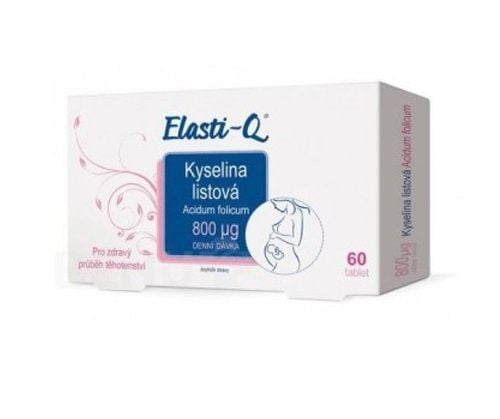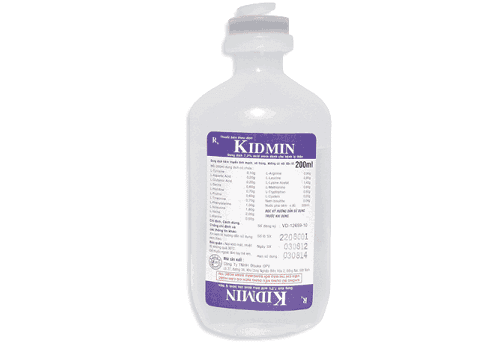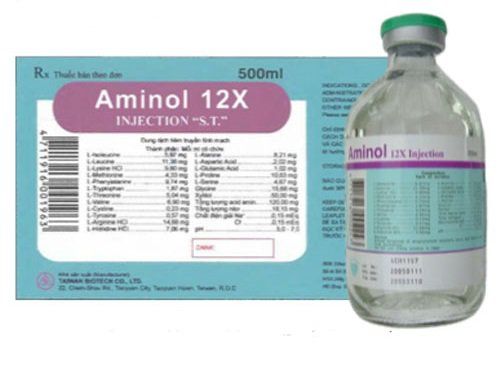This is an automatically translated article.
Clinimix is used as a nutritional supplement to patients, providing macronutrients (amino acids and dextrose) and micronutrients (electrolytes) by intravenous infusion. The following article will provide information about the uses, usage and notes when using Clinimix.1. What is Clinimix?
Clinimix is a prescription medication used as an additional nutritional source of amino acids, Dextrose and electrolytes via intravenous fluids. Amino acids provide the structural units that make up proteins, which are used to synthesize proteins and other biomolecules, or are oxidized to urea and carbon dioxide as an energy source. Dextrose is oxidized to carbon dioxide and water, producing energy. The drug is often used when a patient's diet does not provide enough calories and protein, usually due to certain illnesses or a recent surgery. The drug can also be used to treat negative nitrogen balance in the blood. Clinimix can be used alone or in combination with other medicines.
2. What are the possible side effects when taking Clinimix?
Clinimix can cause serious side effects including:
Shortness of breath, swelling of face/lips/tongue/throat, bloating, blurred vision, chest tightness, chills. Cough, hoarseness, dark urine, little or no urine, dry mouth, extreme thirst, fainting. Heart palpitations, fatigue, fever, flushing, dry skin, clay-colored stools. Back or side pain, nausea, noisy breathing, pain or redness at the injection site. Painful or difficult urination, pale skin, seizures, abdominal pain, sweating. Pain, swelling, heat, skin discoloration and prominent superficial veins over the affected area. Sudden weight loss, vomiting, yellowing of the skin and eyes.
3. Dosage and how to use Clinimix
Mix the ingredients thoroughly by inverting the pouch to ensure a homogeneous mixture. Once the medicine has been mixed, check for leaks. Visually inspect the drug solution for discoloration and unusual particles. Additional amounts of vitamins, electrolytes, trace elements, and other ingredients (including lipids) should be used according to the patient's needs to prevent deficiencies and complications. In addition to meeting protein requirements, the dosing rate should be adjusted, especially during the first few days of treatment, by the patient's tolerance to dextrose. Daily intake of amino acids and dextrose should be gradually increased to the maximum required dose by frequent blood glucose testing. Patients with renal impairment: Before taking Clinimix, severe fluid or electrolyte imbalances should be corrected. Closely monitor serum electrolyte levels and adjust the dose of Clinimix accordingly: Patients with renal failure who do not require dialysis usually need 0.6 - 0.8g protein/kg/day. Serum electrolyte levels should be closely monitored. Patients on hemodialysis or continuous renal replacement therapy should receive 1.2 to 1.8 g protein/kg/day up to a maximum of 2.5 g protein/kg/day based on nutritional status and intake. protein is lost. The dose of Clinimix can be adjusted based on the degree of renal failure and protein supplementation as indicated. If required, additional amino acids may be added to the medication or given separately.
4. Notes when using Clinimix
Clinimix may increase the risk of blood clots forming in the lungs or veins. This can be life-threatening and requires immediate medical attention. Contact a physician immediately if patient develops cough, chest pain, heart palpitations, shortness of breath, dizziness, lightheadedness, fainting or pain, swelling, heat, skin discoloration, and prominent superficial veins on affected area. Serious allergic reactions may occur while using Clinimix. Tell the doctor immediately if the patient has the following symptoms: rapid, shallow breathing, difficulty breathing, fast heartbeat, dizziness, nausea or vomiting, rash or itchy skin, fever, chills. Precipitation of ceftriaxone-calcium can occur when ceftriaxone is mixed with calcium-containing intravenous nutritional solutions, such as Clinimix, in the same intravenous line. Do not use ceftriaxone with Clinimix at the same time via Y-site. Fatalities have occurred in neonates (under 28 days of age) who received concomitant intravenous calcium solutions with ceftriaxone due to calcium-ceftriaxone precipitation in the lungs and kidneys, even when separate infusion lines were used. . Clinimix is contraindicated in neonates receiving Ceftriaxone. In patients older than 28 days of age (including adults), Ceftriaxone and Clinimix can be administered sequentially and the infusion lines should be "washed" between infusions with a compatible liquid. Clinimix may increase the risk of developing infections because the nutritional components of these solutions can support microbial growth. Infection and sepsis can also occur from the use of an intravenous catheter for parenteral nutrition. The risk of infection is increased in immunosuppressed, severely hyperglycemic patients with long-term use. To reduce the risk of infection, ensure aseptic technique when preparing and using the medication. Watch for signs and symptoms (including fever and chills) to detect and treat infections early. Clinimix may affect a patient's blood sugar. Contact your doctor immediately if you experience increased thirst or increased urination. Clinimix may cause liver problems, including liver disease related to parenteral nutrition. This often occurs in patients who have been receiving parenteral nutrition for a long time, especially premature infants. Check with your doctor right away if patient has pain or tenderness in the upper stomach, pale stools, dark urine, loss of appetite, nausea, vomiting, yellowing of the eyes or skin. Clinimix can cause electrolyte imbalance, fluid overload, and aluminum toxicity. Pregnancy: There are currently no adequate studies on the use of Clinimix in pregnant women. It is not known whether Clinimix can harm an unborn baby when administered to a pregnant woman. Lactation: It is not known whether Clinimix passes into breast milk. There are no data on the effects of Clinimix on breastfed infants. The potential benefits and any potential adverse effects to the nursing infant should be considered before deciding whether to administer Clinimix to a nursing woman. Above is the general information about the drug Clinimix. If you have any questions or need more information about your medication, you should contact your doctor or pharmacist. Note, Clinimix is a prescription drug, patients need to use the drug as prescribed by the doctor, absolutely do not self-treat at home.
References: drugs.com, rxlist.com













